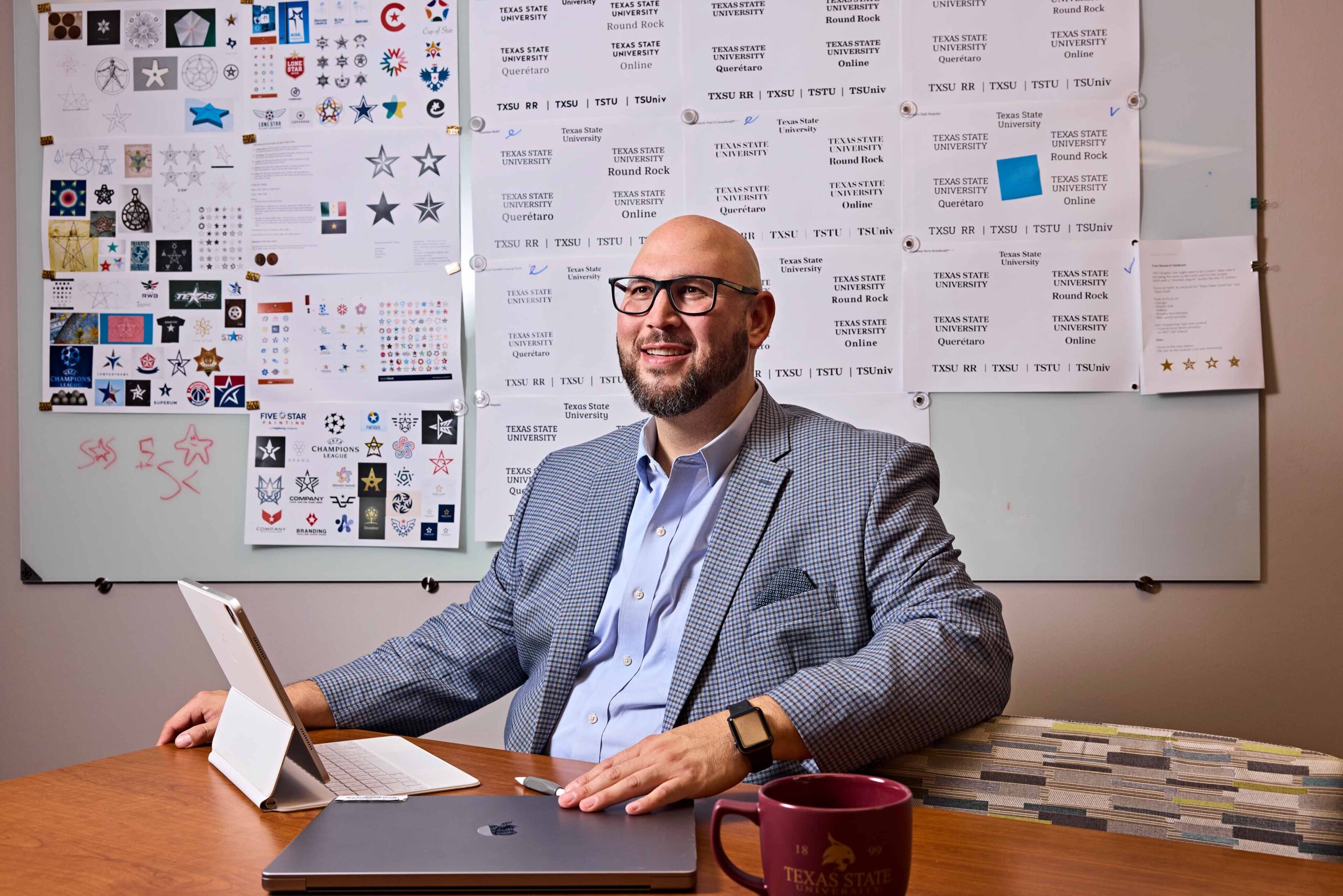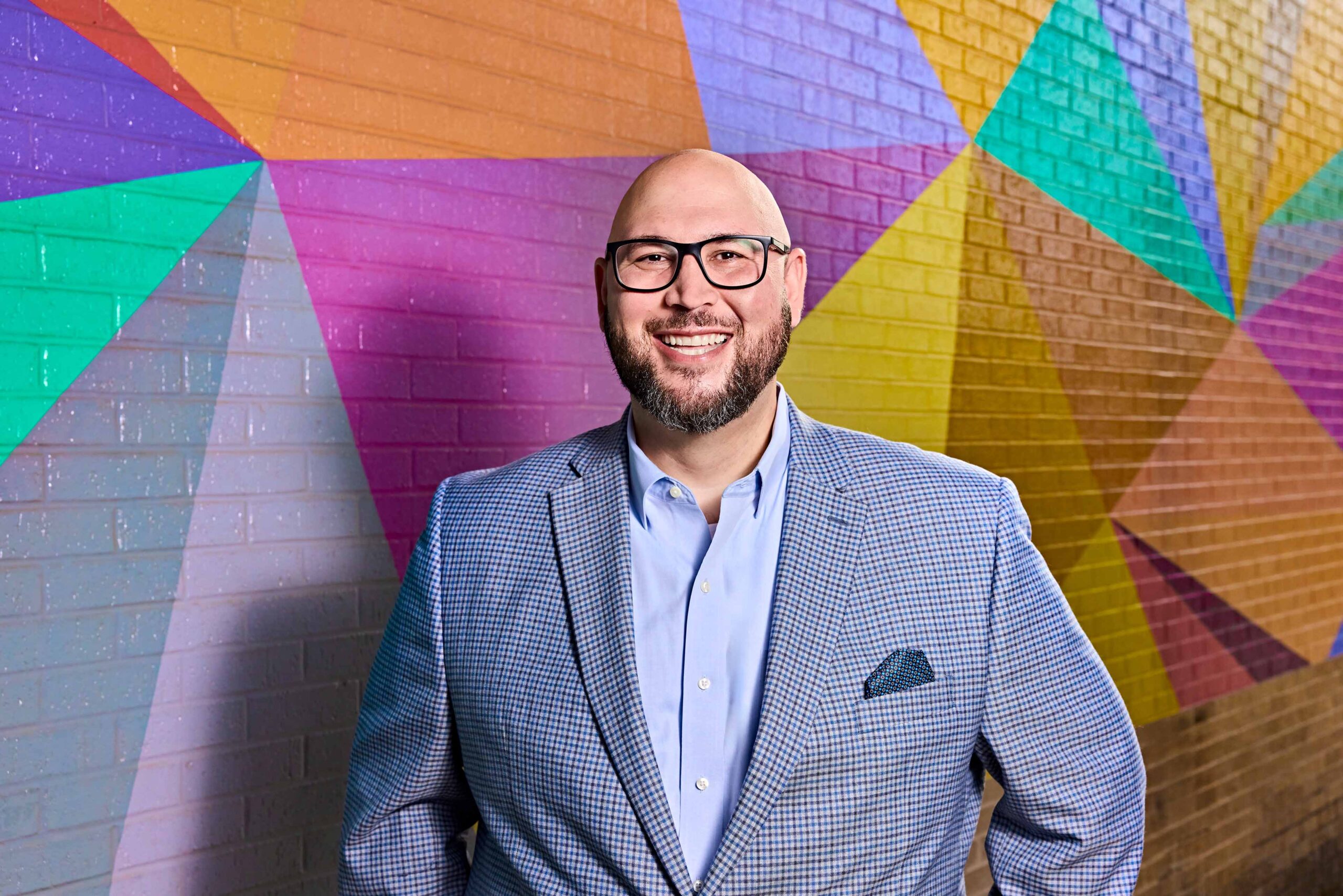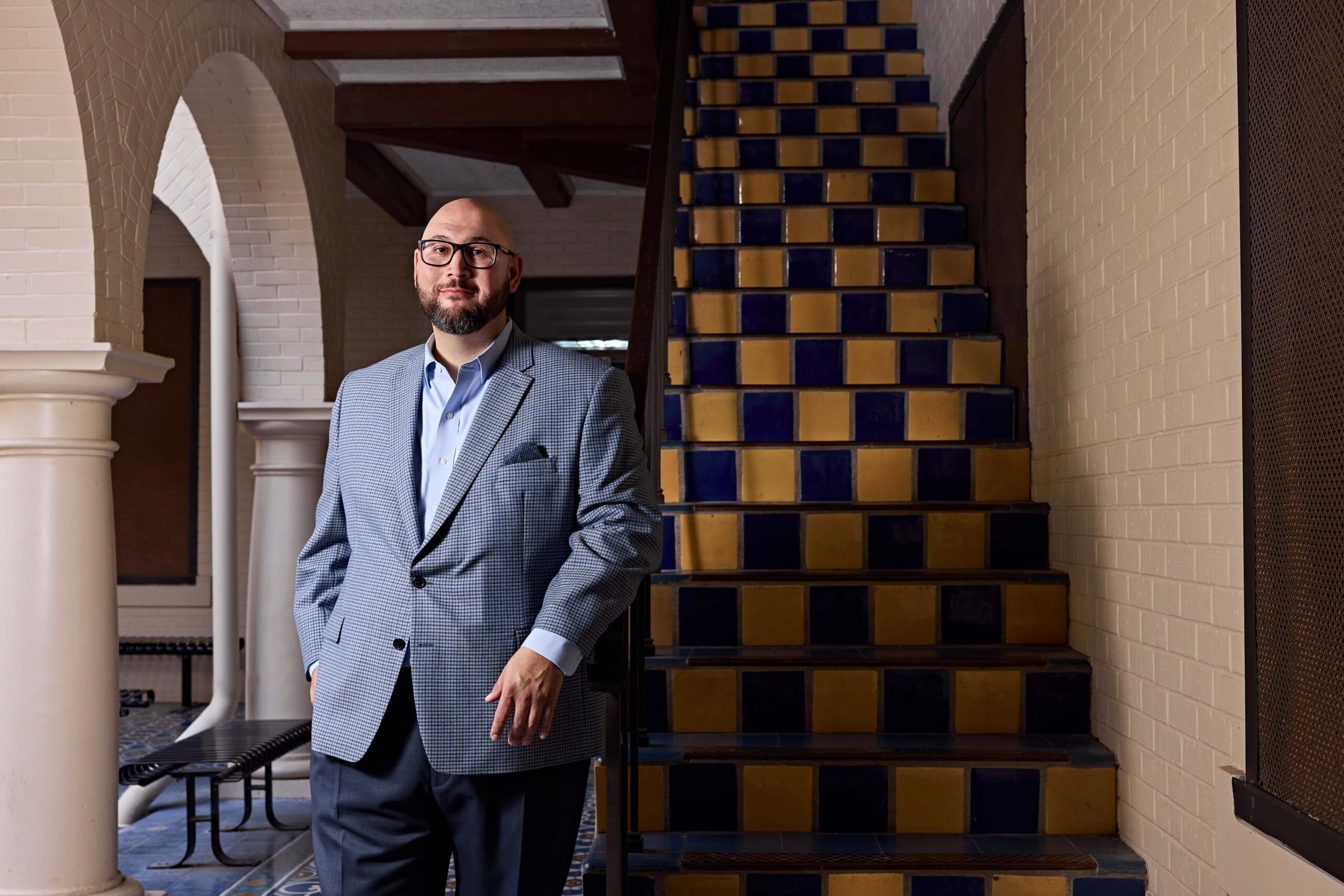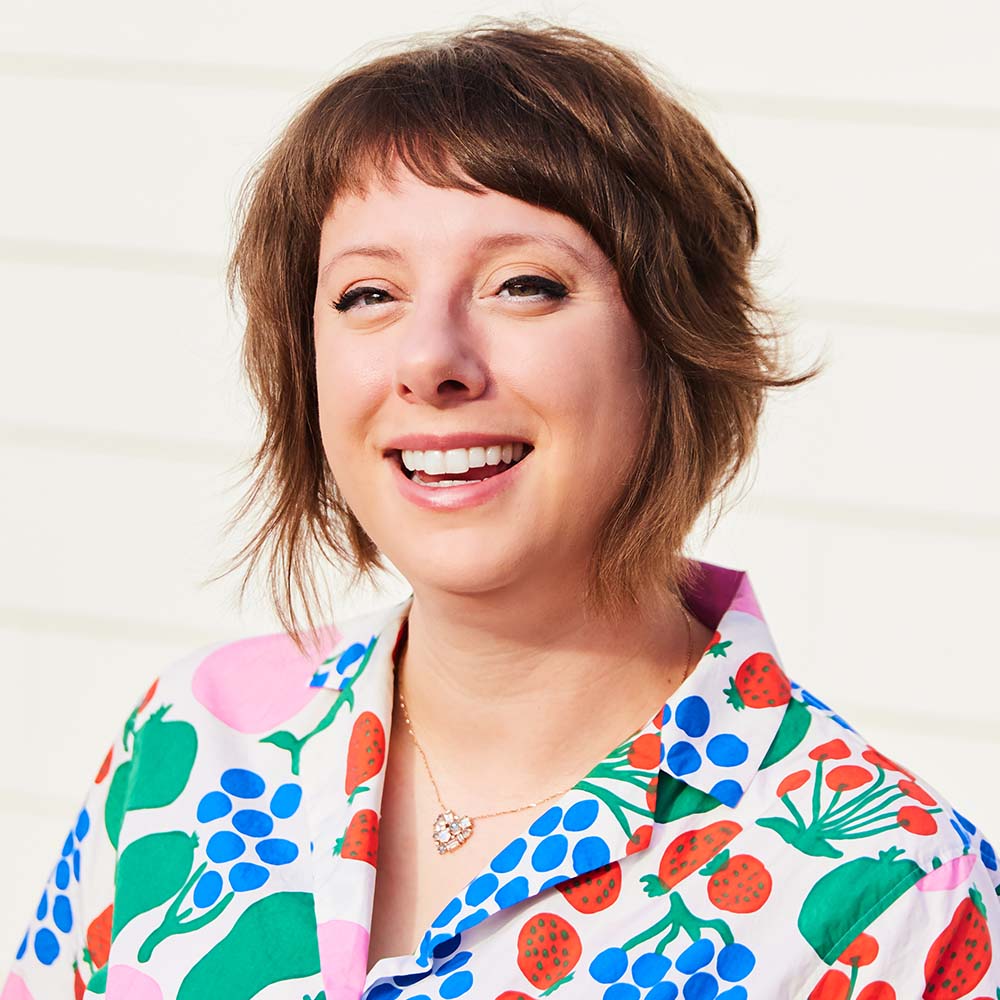The Observer
A conversation with Elias Martinez, associate vice president for marketing and communications, Texas State University.
Portraits by Annie Ray
The Observer
A conversation with Elias Martinez, associate vice president for marketing and communications, Texas State University.
Portraits by Annie Ray
The Observer
E
Elias Martinez, associate vice president for marketing and communications at Texas State University, has a diverse background in the creative industry, helping organizations and institutions clarify their brand. He began his career on the agency side, working with brands like Cheerios, Wheaties, Betty Crocker, Google, Nike, Nordstrom, and General Mills. He transitioned into higher ed as associate VP for brand strategy at Colorado State University in Fort Collins, Colorado, where his team was named “Best in House” by UCDA in 2016.
He currently oversees the brand at Texas State University, including a new brand campaign in 2021. Throughout his journey, he has lived in New Mexico, South Carolina, Kentucky, Minnesota, Colorado, Florida, and Texas, adding to his perspective of place and culture.
A thought leader in higher education marketing, Martinez spoke with The Issue about what is unique about working in the education sector and the importance of understanding your audience to develop custom storytelling.
Kelly McMurray: In 2021, you led a wildly successful campaign for Texas State. I’m curious about the research that went into understanding the prospective audience in order to authentically connect with them.
Elias Martinez: For me, research is about building intuition. Going beyond the “Hey, I’m gonna hire ‘insert agency name here’ to do a perception survey.” Inevitably, they’ll probably find that 90 percent of our students think we’re great, and then we’ll pat ourselves on the back and try to build a brand on that, calling it an insight.
But why do they feel that way? Understanding the why requires getting beyond where we make all of our logical and rational decisions and getting to our lizard brain, which controls our emotions… I really love that Steve Jobs quote about people not knowing what they want until you show it to them. That can only come from building intuition and understanding your target as a human being.
I do a lot of intuition-building through observation. Sometimes, I go out on campus, watch, and try to be thoughtful about what I see. Social listening is a big one, too. What kinds of conversations are happening online about our university? We also co-create with students and act as clients for marketing and communications classes. Seeing the ideas our interns and the classes come up with is always interesting.
I try to pay attention to what’s happening in pop culture and consume some of the same content our students do. I’ll ask my kids, “What’s the newest meme?” “What do you think about Drake and Kendrick Lamar and their beef?” They usually just roll their eyes at me.
Kelly McMurray: That’s so insightful. I’m thinking about, from my personal experience, having my older son go through the college application process and all the materials he received and going on campus visits. One weekend, we went to two different schools, and going into that weekend, his No. 1 goal was “I need to graduate with no debt.” After we walked away and out of that weekend, he picked the school that was going to leave him with a lot of debt. And he said, “I gotta figure this out. I gotta figure out how to go to that school.” And all of that was out of the whole experience of being there that day.
Elias Martinez: Because he felt it was right; he felt it was the place for him in his soul. Then, that logical thought of graduating without debt takes a backseat to his emotions and desire to feel like he’s part of that community. That’s what we’re always trying to do: build an emotional connection.
“I really love that Steve Jobs quote about people not knowing what they want until you show it to them. That can only come from building intuition and understanding your target as a human being.”

“I really love that Steve Jobs quote about people not knowing what they want until you show it to them. hat can only come from building intuition and knowing your target as a human being.”
Kelly McMurray: That’s so true what you’re saying about intuition-based research. I haven’t heard that term, but I think about it when we’re creating or branding a university, you’re branding a place. I wrote an article about branding a university. You’re talking about this place, so how do you capture it? It isn’t as much through the sort of quantitative research, it’s that qualitative research of your listening tours. When we do magazine redesigns, we always — when we can — do a site visit, and just the vibe that we take away from being there influences our design directions.
Elias Martinez: Yes. It’s funny because, being on AMA [the Symposium for the Marketing of Higher Education planning committee] and having a different background from most marketers, I talk a lot about vibe and energy. What is the energy this brand exudes? I do think that universities can lean in that direction more because we’re not a consumer-packaged good or transactional service. People are choosing based on emotional resonance. People look at me like I’m crazy, but in higher ed, I think you can approach marketing less as science and more as art. We can be more about empathy and human connection than impressions and click-through rates or some of those hard marketing metrics.
Kelly McMurray: I totally agree. We talked about this a little bit, but what was the approach for the Texas State campaign, Texas State Next? Now you have that research and then what do you do with it?
Elias Martinez: Higher education in Texas is wildly competitive. It is super duper competitive here. There are tons of institutions. We’re a state that’s still growing. Other states are dealing with population declines. They’re looking to growing states like Texas. We had to stand apart and be a very clear choice apart from legacy institutions like UT and Texas A&M.
So, we realized that we had to do something really distinctive. We had to stand apart on our own and be a very clear choice apart from the legacy institutions in our state. They very much have their own distinct identities that have been built over generations.
While we are a historic university, we are also a challenger brand that has grown and changed a ton over the last 20 years, so we had more leeway to be different. We could ask, “Okay. What is it about Texas State that makes us truly unique so people could just see it and know it’s us?” Everybody has the beautiful campus and the award-winning faculty, and the really great engineering building. These are all product differentiators. So, what we’ve talked about is building a brand strategy emphasizing distinction over differentiation. That was the guiding principle for us.
Points of distinction can even be very tactical like we have an acronym that nobody else in the world has. You can go to an acronym finder, and if you look up TXST, Texas State is the only entry that comes up. So the acronym is, a tactical, distinctive piece of identity or equity that we built upon. You should also build on things underneath the surface that are not readily apparent like almost half of our students are the first in their families to go to college. So, this idea of upward social mobility was key in the brand campaign.
I tell any marketer, any brand builder, that differentiators are how we validate our decisions. Express the distinctiveness of your brand to be recognizable and make an emotional connection because that’s how we decide. I’ll buy a new iPhone because of the brand’s cachet and how I feel about Apple. Then, I’ll use things like the megapixels in the camera, how fast the processor is, and all the apps I can access as differentiated points to tell myself I made a good decision.
“Everybody has the beautiful campus and the award-winning faculty, and a really great engineering building, which are all like product differentiators. So what we’ve talked about is the idea of building a brand based on distinction over differentiation. That was really the guiding principle for us.”

“Everybody has the beautiful campus and the award-winning faculty, and a really great engineering building, which are all like product differentiators. So what we’ve talked about is the idea of building a brand based on distinction over differentiation. That was really the guiding principle for us.”
Kelly McMurray: That’s interesting—another good distinction for me. I love the idea of instinctual versus distinction. I’ve heard you refer to creating marketing for higher ed in the same way we do for lifestyle or youth. I don’t think I have that term exactly right, but I thought that was really interesting. Could you talk a little bit about that approach?
Elias Martinez: All of the best higher ed branding and marketing is approached like lifestyle branding.
You have lifestyle brands like Patagonia and how they stand for the outdoors and the natural world. You have Nike, which is about championing the athlete inside all of us. And here in Texas, we have this grocery chain called H-E-B that celebrates all things Texas. They sell T-bone steaks that are the literal shape of Texas. These companies have built their brands around a lifestyle—the outdoors, sports, Texas—and people gravitate to them because they are part of that culture.
Building a lifestyle allows you to stand out and do interesting things. Instead of just putting our logo on a bunch of T-shirts, we’re actually going to design products for people who love floating the river (Texas State has a spring-fed river that runs through campus). When we do a podcast, we’re not going to do a podcast about some generic research topic; we’re going to produce a podcast that features our professors as people, not just academics. Because, again, we’re building a lifestyle around our brand. It’s more about the energy you put into the world and less about the messaging.
Kelly McMurray: When I think about the work that I’ve done—and what are some parallel markets we can move into, I’ve thought about travel. In higher ed, we’re getting to know a place and capture that place through communications to get people to go there. When we’re creating admissions materials, the goal is to get somebody to go to the school because once they set foot on campus, that’s the game changer. So this is something that came up on the “How the F, Did You Get That Job?” [podcast], that there are alternative pathways to upward mobility and prosperity. I’ve been thinking about my work, working with independent schools, working with higher ed, how can we create communications and legitimize other pathways for people? How can we destigmatize going to vocational school or going to a community college? How can we as an industry work to help people find what’s the right path for them?
Elias Martinez: Mmhmm. That was interesting to me because it’s something that I believe personally. I don’t mean to downplay the value of the four-year degree at all, but a traditional college experience isn’t the only way to advance in life. I guess it’s like the pendulum swinging the other way. We tried to lock students into college. And now we realize it’s not for everyone.
But then there’s also the idea of aspirations, right? And I think there’s a careful balance between creating awareness of the other paths to prosperity and maybe having students believe that college is not right for them because it’s too aspirational. You know, some students don’t test well, they don’t have the resources, or they come from disadvantaged backgrounds. They might not do as well on the SAT or the ACT but can succeed and thrive with a little support.
I really do believe that a four-year college degree is the best thing a student could do, particularly to create social mobility in their life. That’s my story, for sure. I mean, the data shows that your bachelor’s degree-holding student will earn more than a million dollars more over their lifetime than their classmate who only has an associate’s or a high school diploma. When recessions happen, people with four-year degrees are hit less hard they’re laid off at a lesser rate than those without the same education. And when the economy comes back, they’re hired more quickly. So, you know, the four-year college degree is super powerful. And I don’t mean to downplay it at all.
At Texas State, we have a program where students can enroll at Austin Community College and Texas State at the same time. So they get their associate’s degree with ACC, start taking Texas State classes as a junior, and finish with a four-year degree. I really love programs like this as an alternative to the traditional four-year experience. So, I don’t know if it’s the responsibility of higher education or the education industry per se to destigmatize alternative paths. But I do think we can do more to create more of these alternatives so they become normalized and seen as viable. It’s complicated, right?
“Building a lifestyle allows you to stand out and do interesting things. Instead of just putting our logo on a bunch of T-shirts, we’re actually going to design products for people who love floating the river (Texas State has a spring-fed river that runs through campus).”

“When you move into that lifestyle values piece, it allows you to do other things — instead of just putting a logo on a bunch of T-shirts, we’re actually going to design apparel that people or our community who share these beliefs will want to wear.”
Kelly McMurray: It is complicated, and I agree with you. You don’t want to swing too far. I think right now, the United States is at a place of just such criticism over higher ed. We have a lot of liberal arts college clients, and they are addressing the value of still going into college and exploring different things. I was talking to a friend last week about her daughter, who scored almost a perfect score on the ACT. She is taking a gap year, because she felt that the school she was applying to demanded for her to claim her major right away and know what she wanted to do. But she’s like, I don’t know, I just want to go to college and learn and grow.
Elias Martinez: I really do believe, and this may seem counterintuitive, that the liberal arts and personal growth are going to make a big comeback thanks to AI. And I’m here for it and hope it happens. So, AI is supposedly a much better coder than your average person, and it doesn’t need to eat, it doesn’t need to sleep, and it doesn’t need vacation days. As AI became more prevalent, many of the tech companies started massive layoffs because they planned to rely on AI for some tasks that people with salaries used to do. Their stock value shot through the roof because they maintained their profits while cutting overhead.
But the thing that AI cannot do is what the liberal arts and the humanities teach us, which is how to connect with other people and think critically. Our country is very polarized right now, and it’s because we’re not prioritizing the humanities, in my opinion. So if liberal arts institutions can get their minds around how to tell that story and carve out that position, a lot of people are going to be like, “Well, yes, of course.”
You know, for my kids, my wife and I don’t even know where to steer them right now. Before, it would be, well, go be an engineer, go be a lawyer, go be a doctor. But AI has completely changed all of that, and liberal arts universities can capitalize on it.
Kelly McMurray: I love that. So, right here, in Albany, the College of Saint Rose just closed—my husband taught there, my two designers went there. Since 2011, I’ve hired 10 or 11 graduates and other interns from there, and it just had an amazing program. But I think the school really failed to tell that story. I think it tried to be everything like, oh, wait, we need a nursing program. Oh, wait, we need, you know, cybersecurity, while there were schools in the regions already doing these things really well.
So this kind of leads to my next question: Who is your target audience? When my husband was applying for a position at Saint Rose, I was like, “Well, who goes to art school in Albany, New York, when you’ve got New York City and Boston?” Once you are here, you really get to understand who that demographic is. If Saint Rose had really focused on that, and marketed to the demographic instead of trying to split the school, maybe they would still be in business.
Elias Martinez: Or even like, what makes the College of Saint Rose different? That’s where brand distinction comes in.
There’s a school—I can’t remember the name right now—that has this program called Flightpath, which allows students to design their own degree. It’s really amazing because it’s a clearly distinctive attribute they could build an entire brand around—the idea of college as a choose-your-own-adventure book. They can be the college that doesn’t put students into a box based on its degree offerings. Rather, it can be the college that allows students to curate its resources to get the experience they really want. This takes universities back to a place of building knowledge and life skills instead of just credentialing.
So, I would say the university should start by knowing itself before it even begins to think about its target audience. If you understand who you are, you’ll understand who your students are.
Share this article

Annie Ray is a photographer based in Austin, TX. Her work encompasses editorial, conceptual, and professional headshots. Annie’s awards include The Chronicle’s Best Of Austin: Photographer for ten years in a row. Outside of client work, Annie does romance novel photography for authors and stock photos for her website, Passion Pages. She’s also the founder of You Got This!, a photo company that adds spunk and pizazz to companies through headshots and work lifestyle imagery.
